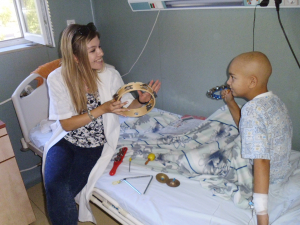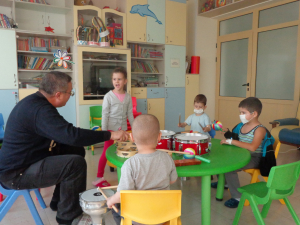
ARTON PROGRAM - The therapeutic power of the group
Creative projects involving group work - general musical performance or group painting, collage, sculpture - are useful in helping to explore and strengthen social...
Play therapy is a type of therapy that, as the name suggests, involves playing. It has been around for a long time, even in an academic context. Recently, play therapy has been refined and targeted to a variety of different disorders, from autism spectrum disorder (ASD) to attention-deficit hyperactivity disorder (ADHD). Play therapy has also been used in normal functioning children and adults to great effect. This article will explore what play therapy is and some of its benefits, as well as how to become a play therapist if it is something that interests you.
Play therapy is a type of therapy that has been around in psychiatry since the 1930s and may have been around for hundreds or even thousands of years before then. Academics in the 1930s felt the value of play therapy was “that the child revealed far more of himself when talking about things he liked to do, his favorite toys, his pets, his friends, etc., than when he was face to face with a psychiatrist who questioned him first about his troubles” (Gitelson, 1938). This belief still drives much of play therapy today. Nowadays, play therapy is defined by the Association for Play Therapy (APT) as “the systematic use of a theoretical model to establish an interpersonal process wherein trained play therapists use the therapeutic powers of play to help clients prevent or resolve psychosocial difficulties and achieve optimal growth and development” (Association for Play Therapy).
They also define it in a simpler way by saying “child play therapy is a way of being with the child that honors their unique developmental level and looks for ways of helping in the “language” of the child – play”.
Based on these definitions, it is clear that the APT considers the healthy development of a child to be the primary goal of play therapy. According to the British Association of Play Therapists (BAPT), play therapy lets children sort through complicated feelings and “use play to communicate at their own level and at their own pace, without feeling interrogated or threatened” (British Association of Play Therapists). This is a key aspect of play therapy since traditional therapy can often feel intimidating for children (and adults as well), which does not necessarily lead to a conducive environment for self-expression. BAPT’s definition also underscores an important aspect of play therapy, which is the idea that the client can feel in control of how much they reveal about themselves.
To sum up, play therapy is a type of therapy where therapists allow clients (who are often but not always children) to play during sessions, rather than simply sitting with clients and asking them questions about their problems. Play therapy can be nondirective, as in the case of allowing a client to play with sand to relieve stress, or directive, as in the case of having a client tell a story about a family using puppets to learn more about the client’s family dynamics. Play therapy can also be adapted to the client, as very young children play in different ways than adolescents and adults. The idea of play therapy is to let clients settle into a more comfortable situation where they are more willing to express themselves than they would be in a traditional therapy session.
Just as there are many different ways that children play, so are there many different types of play therapy.
For example, according to Allen & Hoskowitz (2017), there is:
There is also Parent-Child Interaction Therapy (PCIT), which, as the name suggests, involves the parent (Zlomke et al., 2017). If you want to see the variety of play therapy techniques that are put into practice around the world, though, the book Essential Play Therapy Techniques (Schaeffer & Cangelosi, 2016) is a must-read. The book details 58 different play therapy techniques. For people who do not have time to read through the book, take a look at the table of contents, grouped by type of play therapy. Below, you will find examples that have been pulled from various parts of the book (as well as other sources).
Ball Play
For example, in a group therapy session, a therapist might have a group take turns throwing a ball around, and anytime someone catches the ball they have to say something that makes them happy. (Hudak, 2000)
Plush Doll Play
For example, the therapist might present the client with a few stuffed animals (or ask the client to bring their own) to help comfort the child during a therapy session. (Schaeffer & Cangelosi, 2016)
Medical Play
For example, a client who has just undergone a stressful medical procedure might do a play examination on one of their stuffed animals, so they can feel a sense of control. Alternatively, the client may re-enact or roleplay hospital procedures in such a way that they have fun “doctoring” the therapist (Froehlich, 1984).
Baby Doll Play
For example, a therapist might use a baby doll to model positive, nurturing behaviors for the client, or might let the client play with the doll to see what the client’s instincts are. If the client starts mistreating the doll, it is possible that the client is being mistreated by their own parents (though of course, it does not necessarily mean that; Ater, 2001).
Baby Bottle Play
This form of play can be valuable for exploring different familial roles through symbolic play, such as the role of the carer. An example is if the client were to fill up and offer the therapist a bottle as an act of nurturing (Ryan & Wilson, 1995). This act may then facilitate discussion about the client’s own experiences of caring and being cared for.
Toy Telephone Play
For example, the client and the therapist might each have a toy phone, and the therapist can ask therapy-related questions on the phone. The client might be more comfortable indirectly answering questions like this, and if they feel uncomfortable they can just hang up. This indirect form of communication has been shown, in particular, to help children struggling with elective mutism (Rosenberg & Linblad, 1978).
Magic Wand Play
For example, the therapist might give the client a magic wand and tell them they can make three wishes. At least one of the wishes is likely to relate to a real-life problem the client has. This play technique is effective for helping clients to safely verbalize their wishes or goals, as well as aspects of their environments (e.g., at school or in their home) that may be troubling them (Kaduson & Schaefer, 2003).
Bubble Play
For example, the therapist might simply let the client run around blowing bubbles and popping them for stress relief reasons or to help a child bond with other children in a group session (Schaeffer & Cangelosi, 2016).
Block Play
For example, the therapist might construct a wall of building blocks and allow the client to throw a ball to knock the blocks down. This can help the client release anger. A variation of this technique, developed by psychologist Robert Resnick (2002), can support a pair of clients in strengthening their communication and listening skills. Both clients have an identical set of blocks and are concealed from view of each other. Each then takes turns building a construction out of their blocks, while verbally directing the other person to build an identical construction.
Concrete Play Metaphors
For example, a therapist might present dozens of toys to the client, then ask them to pick out toys that represent family members. This can help the therapist see what the client thinks and feels about their family members (Schaeffer & Cangelosi, 2016).
Turtle Technique
For example, a therapist might give a client a turtle puppet, and explain that when the turtle is upset about something it stops, goes into its shell, closes its eyes, and takes three deep breaths. The client can then play out this process with the turtle puppet, and this can help the client learn anger-management techniques (Schneider & Robin, 1974).
Emotion Thermometer
For example, the client might be presented with an “emotion thermometer” showing a range of emotions from 0 (with a smiling face) to 10 (with a frowning face) and asked to list events that make them feel like they are on different points on the thermometer. This might sound like, “What types of things make you feel like a smiling face? What about a frowning face? What about a medium face?” It has been shown that children who are taught to monitor and regulate their emotions using this technique are likely to engage in fewer aggressive and disruptive behaviors and display improved behavior in the classroom (Wyman et al., 2010)
Mutual Storytelling
Developed by child psychiatrist Richard Gardner (1971), this technique involves the telling of stories by both the client and the therapist. In this, the client (usually a child aged 8-14) is invited to tell a made-up story using fictional characters. At the end of the story, the child is asked to explain the lesson or moral of the story, and then the therapist re-tells the story using the same characters but offering more adaptive solutions to the conflicts faced by the characters. To illustrate, imagine a child patient was to tell a story about two children fighting over a toy. If the child’s resolution to the story involved one child using force to take the toy, the therapist’s adaptive version of the story may depict the two children reaching an agreement to take turns and share the toy.
Externalization Play
For example, the client and therapist might work together to create a character that represents one of the client’s problems, such as a dragon that represents the client’s fear. The therapist can then ask questions about the problem without directly addressing the client’s fear, by externalizing the problem to the dragon (Schaeffer & Cangelosi, 2016).
Bibliotherapy
For example, the therapist might find a story or book that involves a problem similar to the client’s problem, and that provides a solution to this problem (Schaeffer & Cangelosi, 2016). While reading this story with the client, the therapist might ask questions relating the story to the client’s life, such as, “Have you ever felt this way?”.
Role-Play
For example, the therapist and client might role-play a situation the client is anxious about, such as the first day of school, so that the child can work out what they feel anxious about and possibly realize they do not need to be anxious at all (Schaeffer & Cangelosi, 2016).
Costume Play
For example, the therapist and client might pretend that the client is being crowned the new king or queen of a land. The therapist can then ask what the new king or queen wants to do with their power, to figure out what the client likes and dislikes (Marcus, 1966).
Mask Play
For example, the therapist might ask the client to make two collages (masks) out of magazines. One mask (the “outside mask”) is how they think the world sees them, and one mask (the “inside mask”) is how they see themselves. This can reveal a lot about how the client thinks of themselves and the world (Schaeffer & Cangelosi, 2016).
Superhero Play
For example, the therapist might ask the client to draw a superhero with superpowers that the client would like to have. The therapist can then help the client figure out how their personal strengths can be as useful as these superpowers (Rubin & Livesay, 2006).
Puppet Play
Puppets are frequently used tools in play therapy, which can be employed in a variety of ways (see Drewes & Schaefer, 2018). One popular technique is called the Family Puppet Interview. When facilitating this form of play, the therapist will present the client and the client’s family with dozens of puppets, then ask the client and the client’s family to each choose a puppet to represent them. The client and the client’s family then tell a story using the puppets, and the therapist interviews each family member about the story then discusses the story with the whole group. This can reveal certain family dynamics that the client is unable or unwilling to directly discuss with the therapist (Irwin & Malloy, 1975). Communicating through puppets has also been shown to help clients struggling with elective mutism (Rosenberg & Lindblad, 1978).
Color Your Life
For example, the therapist and client might work together to figure out which colors represent which feelings (such as blue for sad, red for angry, yellow for happy, etc.). The therapist can then ask the client to draw a timeline of their life, using the colors to represent feelings. The therapist can also ask the client to draw different aspects of their life, such as school or sports (O’Connor, 1983).
Clay Play
For example, the therapist might give the client a ball of clay and let them do whatever they want with it. Unstructured clay play has been shown to be effective for relieving stress (Kimport & Robbins, 2012), but it can also be used to encourage clients to sculpt things that are important to them or troubling them that they can talk about with the therapist.
Free Drawings
Free drawing is a widely used play therapy technique that serves a range of functions (Golomb, 1992). It can help therapists develop a rapport with new clients, encourage clients to express their emotions, and reveal unconscious disturbances that spark discussion. For example, the therapist might simply give the client paper and some crayons (or any drawing materials) and ask them to draw a picture. The therapist can then ask open-ended questions about the picture once it is complete.
Trauma Drawings
For example, the therapist might ask the client to draw a traumatic experience in the client’s past, such as an earthquake. Research has shown that the act of then crumpling up the paper and throwing it away can invoke a sense of control over the traumatic event and be therapeutic for the client (Pynoos & Eth, 1986).
Mandala Drawings
For example, the therapist might give the client a mandala template and ask the client to color it in. The client can then make their own mandala and color in it if they wish.
This activity can help foster creativity and relaxation (Schaeffer & Cangelosi, 2016).
Serial Drawings
For example, the therapist might ask the client to draw a picture (nondirected) every session. After the picture is drawn, the therapist and client can talk about it, with the therapist not taking notes so it is clear they are present. These drawings over time might show the client’s state of mind as the therapy process progresses (Schaeffer & Cangelosi, 2016).
Collage
For example, the therapist might ask the client to collage a nightmare they have been having on the inside and outside of the box. The client can then play with the box to become less scared of it. Collages can be a great medium of expression for clients who don’t consider themselves artistic and perhaps shy away from painting or drawing (Schaeffer & Cangelosi, 2016).
Painting
Similar to free drawings, the therapist might ask the client to finger paint whatever they want, after which the therapist can ask the client to tell a story about the painting (Schaeffer & Cangelosi, 2016).
Dance/Movement Play
For example, the therapist might have a client simply play with a hula hoop, so that they focus and relax, which might put them in a better state of mind for a therapy session. This technique can also help clients to integrate facets of the mind and body (Krueger & Schofield, 1986).
Draw a Family
For example, the therapist might ask the client to draw a picture of their family. Once the picture is drawn, the therapist can ask which drawing is which member of the client’s family and discuss whatever the client wants to discuss about the drawing. The ways various family members are drawn can be revealing and has particularly been shown to help elucidate clients’ experiences of a blended family environment (Berger, 1995).
Family Sculpting
Similar to the Draw a Family technique, the therapist might ask the client to use clay to sculpt their family members, including the client themselves. Once each family member has a clay figure, the therapist might ask the client to place them in relationship to each other, which can show the therapist how close or far from each family member the client feels themselves to be.
Musical Play
For example, the therapist might present the client with a number of toy instruments and simply ask the client to make up a song or play along with another song. This can help the client express themselves, build self-esteem, and improve the therapist-client relationship (Moreno, 1985).
Guided Imagery
For example, a therapist might ask the client about a nightmare they have been having, then explain to the client that nightmares are like movies, and tell the client that they can change the nightmare if they do not like it. The therapist can then work with the client to figure out a happier ending for a nightmare, in an attempt to retrain the client’s brain to feel more control (Kaduson & Schaefer, 2003).
The World Technique
For example, the therapist might give the client a tray half-filled with sand, and dozens of toys, including people, fantasy figures, and scenery. The therapist then allows the client to build their own world without providing any guidance or judgment. The therapist then asks the client questions about the world, still without providing any guidance. The idea is that the world the client builds might involve themes the client deals with in real life so that the world can be an opportunity to work through some of these issues (Hutton, 2004).
Dollhouse Play
For example, the therapist might give the client a dollhouse and some dolls representing their family members. The therapist can then ask the client to model four different everyday scenarios in their real house: bedtime, dinnertime, playtime, and clean up time, to figure out more of the client’s family dynamics (Warren et al., 1996).
Adaptive Doll Play
For example, the therapist might give the client a few dolls to represent themselves and their family members and ask them to play out a scenario that is similar to a real problem the client is having. The therapist can then help the client figure out ways the client can respond to these scenarios so that they have more positive outcomes. Evidencing the efficacy of this play technique, one case study found that adaptive doll play reduced clinging behaviors, crying, and children’s requests to call home while at school (Danger, 2003).
Rosebush Fantasy Technique
In this technique, the therapist asks the client to close their eyes, imagine that they are a rosebush, and describe this rosebush, including where it is, who cares for it, and any roots, thorns, or flowers it might have. The client can then draw the rosebush and tell its story to the therapist, at which point the therapist can ask which parts of the rosebush and its story the client identifies with. This metaphor of the rosebush can facilitate communication of the client’s needs, feelings, and experiences (Stevens, 1971).
Family Relations Technique
For example, the therapist might put a number of mailboxes in front of the client, one for each family member and one for “Mr. Nobody”. The therapist then gives the client “mail”, which consists of strips of paper that read things like “loves me”, “hates me”, “protects me”, “hurts me”, and asks the client to put these pieces of mail in each appropriate mailbox (so if the client thinks their dad loves them, they would put a “loves me” paper in their dad’s mailbox). This can help the therapist further understand family dynamics (Schaeffer & Cangelosi, 2016).
Worry Dolls
For example, the therapist might give the client a set of Guatemalan worry dolls or help the client make their own. The therapist can then ask the client to assign a worry to each of these dolls, put the dolls in a box, and leave the dolls in the therapist’s office so that the dolls can worry about the client’s issues instead of the client having to worry about them. In future sessions, the therapist can bring these dolls out one-by-one to discuss these worries and how the client is dealing with them (Schaeffer & Cangelosi, 2016).
Tea Party Play
For example, the therapist might throw a tea party celebration for the client, to commemorate progress the client is making during therapy sessions or achievements the client has reached outside of therapy. This positive reinforcement can help raise the client’s level of self-esteem and strengthen the relationship between the therapist and the client.
Tea parties can also be a mode to explore themes such as nurturance and reciprocity (e.g., ensuring to pour tea for everyone around the table; Ryan & Wilson, 1995).
Communication Games
For example, the therapist and client might play “The Talking, Feeling, and Doing Game”.A turn of the game might look like this: the client draws a card that says “Make believe that something is happening that is scary. What is happening?” and if the client does what the card says, they get a chip.During the game, the therapist can see how the client reacts in certain situations and advise them on how to react in these situations (Gardner, 1973).
Self-Control Games
For example, the therapist and client might play “Simon Says”, where the client has to do what the therapist says (such as jumping on one foot), but only if the therapist started their sentence with “Simon says…”. This can promote paying attention and self-control, as the client has to pay attention to what the therapist is saying and only do what the therapist says in certain situations (Schaeffer & Cangelosi, 2016).
Strategy Games
For example, the therapist might simply play a familiar strategy game with the client, such as chess, checkers, or pick up sticks. This can help the client focus and feel happier, as well as foster a bond between the client and therapist. These games can be especially useful during early therapy sessions if the client is uncomfortable with the therapist or the idea of therapy itself. These games may help a client feel a sense of control and mastery or strengthen impulse control and self-regulation in their efforts to master the game. The chess pieces may also be seen as embodying parental symbols and, therefore, help spark conversation regarding family members (Fried, 1992).
Cooperative Games
For example, the therapist might play a cooperative game with the client, such as a game like Max the Cat, where players have to help a mouse, bird, and chipmunk get home before Max the cat eats them. Playing cooperative games like this can help the therapist-client relationship or the client’s relationship with family members who are also participating in therapy. It can also help the client build social skills, especially if they have trouble working together with their peers (Guttentag & Alex, 1997).
Chance Games
For example, the therapist might play a game with the client that is mostly determined by chance, such as the board game Candy Land or the card games War and Go Fish. Like the other types of games mentioned above, these games are familiar and can help the client ease into a therapy session, as well as help the client build a relationship with their therapist. Since these games are mostly determined by chance, they also offer the client an opportunity to cope with unexpected losses that they could not have avoided and give therapists the opportunity to walk the client through these situations (Schaeffer & Cangelosi, 2016).
Squiggle Game
For example, the therapist might close their eyes and draw a random squiggle on a piece of paper, then ask the client if the squiggle looks like anything or makes them think of anything. The client can then draw their own squiggle and ask the therapist if they think it looks like anything. The therapist and client take turns drawing random squiggles for each other to see if they can find anything in the squiggles. This game can help the client feel more comfortable in a therapy session, and can also work as a sort of Rorschach test for the therapist to find out more about how the client thinks.
Desensitization Play
For example, a therapist might help a client work through their fear of the dark by desensitizing them to darkness. This might be accomplished by having the client and their parents play fun games at night in a gradually darker room so that by the end the client is still having fun despite being in the dark. This can show the client that there is nothing to be afraid of (Kelley, 1976).
Laughter Play
For example, the therapist and client might take turns trying to make each other laugh in any way they can (without touching each other). The client’s parents can also play a tickling game with the client for the sole purpose of making the client laugh. Laughter causes lower levels of stress and can improve relationships (Puder, 1998), so either of these options are useful since an improved parent-child relationship and an improved client-therapist relationship are both beneficial.
Stress Inoculation Play
For example, the therapist might have the client play out a future stress-causing situation, such as an upcoming class presentation. The client can use toys to work out what might happen during the presentation, and the client might realize that the situation is not as scary as it first seemed. The therapist can also offer coping strategies for the client based on the client’s fears about the presentation (Schaefer & Drewes, 2013).
Reenactment Play
For example, the therapist might recreate a stressful event for the client, such as a car accident, using toys in the playroom. The client can then freely play with the toys in a non-directed manner. This reenactment may help the client to gain a sense of control over the situation and let go of lingering feelings of trauma and fear through a process of desensitization. It may also allow the therapist to strengthen their understanding of personal meanings associated with the trauma as it is acted out in the form of a narrative (Schaefer & Drewes, 2013). According to Schaeffer and Cangelosi (2016), these reenactments often need to happen multiple times over multiple sessions for optimal results.
Hide-and-Seek Play
For example, a therapist might create hiding spaces in the playroom so they can play hide-and-seek with the client. This game is an avenue through which the therapist can explore issues such as separation anxiety, loss, or abandonment (Frankiel, 1993). Of course, it may also simply serve as a fun activity the therapist and client can bond over (Schaeffer & Cangelosi, 2016).
Magic Tricks
For example, the therapist might ask the client if they want to see some magic, show them a magic trick, and then show the client how to do the magic trick themselves. This is a fun activity that can help the bond between the therapist and client. Showing the client how to do the trick themselves can also give the client a feeling of control and mastery, which can raise their levels of self-esteem.
Feeling Faces
For example, the therapist might decorate their playroom walls with “feeling faces”, or faces that demonstrate different feelings such as happiness or anger. The therapist can then start off the therapy session by asking the client to point to a face that they identify with at the time, which can give the therapy session some direction. They can also be helpful for clients to show how they are feeling throughout the session without having to use words (Curry & Frazio-Griffith, 2013).
Suitcase Playroom
For example, a therapist might create a “suitcase playroom”, which is simply a suitcase filled with the toys and materials necessary for play therapy. This is helpful for play therapists who do not have dedicated playrooms. The play therapist can then open up the suitcase to start each session and pack it up at the end of each session. This is not only practical for smaller therapy spaces, but also shows the client that the therapist cares for them since they are going out of their way to bring all these toys for the client (Schaeffer & Cangelosi, 2016).
Play Therapy Rituals
For example, a therapist might start every session with the client in the same way, perhaps by saying hello, asking the client to remove their shoes, and then starting the squiggle game. This predictability can show the client that play therapy is a safe space for them and can raise their levels of self-esteem and feelings of control. Rituals can also take place at the end of each therapy session so that the client knows that every session will end with a free drawing (Schaeffer & Cangelosi, 2016). Some of these techniques are designed to help children reduce their aggression, while others are meant to be escapist fantasy games. Other techniques on this list involve representational play, where children can detail their problems to the therapist without doing so explicitly. Some are simply meant to help children pay better attention to aspects of the world around them. This wide variety of techniques underscores how valuable play therapy can be to all sorts of children since there is a technique for just about every type of play a child might prefer.
While play therapy might sound like it is for children (since we usually associate playing with childhood), it is also extremely useful for adults.
According to Schaeffer (2002): “play is a wholistic experience in that it invites our total being into the process”. Schaeffer goes on to say that play can raise our self-esteem, nurture stress release and allow insight into things going on in our lives. These are all qualities that are clearly helpful for adults along with children, yet most people still think of play as something for children. The idea of play therapy for adults is not to force adults to play, but to offer them the opportunity to work through feelings that they do not have the words for. Some types of play therapy which Schaeffer recommends for use with adults include dramatic role-play and sand play. Play therapy has also been used successfully in a case study involving elderly adults in nursing homes (Ledyard, 1999). This study found that play therapy led to decreased levels of depression and increased levels of self-esteem, among other benefits. These benefits, of course, would be desirable for any population, furthering the idea that play therapy could be as useful for adults as it is for children. The idea of play therapy for children is that playing is the “language” of children, but this does not mean that adults would not be able to express difficult ideas while playing as well.
Trauma
Play therapy has increasingly been used with children who exhibit symptoms of post-traumatic stress disorder (PTSD). One such case involves two children who were traumatized by the effects of Hurricane Katrina in the Southeastern United States in 2005 (Dugan et al., 2009). One of these children showed fear around water, such as during bath time or when thunderstorms would appear, and also refused to sleep by himself. In his first play therapy sessions, he exhibited themes of control, safety, and aggression. After a few sessions, he started showing nurturing themes in his play, as well as trauma re-creation where he “drowned” characters in the sandbox. By the eighth session, the child was able to enjoy himself at a water park without being scared of the water, and after a few additional sessions, he was able to sleep by himself again. The success of this play therapy can partially be attributed to the repetitious nature of the play, where the child was able to desensitize himself to the source of his trauma. The child also indicated a higher level of independence, perhaps due to the fact that he could choose how to work through his issues in play therapy. This type of repetitious play therapy is especially valuable for young children who might not be able to recover as well in a traditional cognitive-behavioral therapy program.
Anxiety
Child-Centered Play Therapy (CCPT) has been found to be effective in treating anxiety in six- to eight-year-old children (Stulmaker & Ray, 2015). Specifically, 12-16 individual half-hour sessions of CCPT over eight weeks reduced self-reported anxiety symptoms in children more than sessions where children just colored with a counselor. This is promising, since anxiety is “considered one of the most current and pervasive childhood disorders, with a poor prognosis if left untreated”, and traditional methods of treating anxiety do not always work with children (Stulmaker & Ray, 2015). Cases of childhood anxiety highlight the importance of play therapy. By providing therapy in a lower-pressure environment where even young children can understand what is going on, play therapy can be an invaluable resource for parents and schools. The Stulmaker & Ray study also claims that play therapy can be a preventative factor in childhood anxiety, on top of being an available intervention for existing anxiety.
ADHD
Play therapy has been increasingly used in cases of attention deficit hyperactivity disorder (ADHD) since one of the challenges that can come with childhood ADHD is difficulty playing with other children (Wilkes-Gillan et al., 2014). One such study by Wilkes-Gillan et al. in 2014 focused on children who had already undergone a play therapy program with a licensed therapist. In this study, children underwent a seven-week program that involved parent-led home sessions and three clinical therapist-led play therapy sessions. The study showed evidence of increased prosocial behavior during playtime, especially in the clinical, therapist-led sessions. Parents also reported that seeing their children in the therapist-led sessions helped them lead the parent-led sessions. This study shows that there is a promising future for parent-led play therapy sessions for children who have ADHD.
In Schools
The Stulmaker & Ray (2015) study shows the value of play therapy in schools, especially since play therapy had a preventative effect on anxiety and worry levels. Another study showed that 26 sessions of Child-Centered Play Therapy (CCPT) led to increased academic achievement long-term in normal functioning first-grade students (Blanco et al., 2017). Interestingly, these improvements in academic achievement differed from child-to-child, with some improving more in math and others improving more in reading, for example. This indicates that play therapy has individualized effects on each child, which makes sense since the way a child plays is unique to them. Since one study focused on preventing anxiety symptoms and the other focused on academic achievement in normal functioning children, this indicates that play therapy can be extremely valuable for schools, since it can be applied to all children. Play therapy is also valuable for schools since it can easily be implemented, as most schools have school psychologists and all children enjoy playing in some way or another. Most importantly, play therapy is effective with extremely young children in a way that other therapies are not (Stulmaker & Ray, 2015).

Creative projects involving group work - general musical performance or group painting, collage, sculpture - are useful in helping to explore and strengthen social...

In the ARTON Program our team of oncopsychologists, art therapists and music therapists develops the process of children's creativity as a process of...

In ARTON sessions, creating a piece of music or a song is an emotional experience of coping and satisfaction for the participating children. They make friends with...

Painting provides patients with a spontaneous, plastic method of depicting thoughts and experiences. Painting with paints is not as structured as with pencil or...










